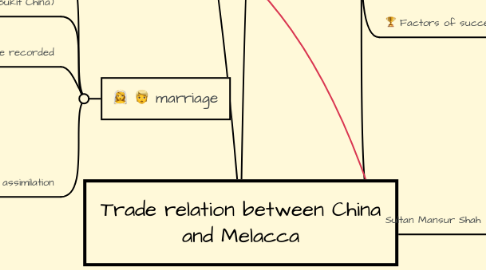
1. China
1.1. Ming Dynasty
1.1.1. sent Admiral Zheng He
1.1.1.1. expand its political influence
1.1.1.2. recognition of the role of Malacca as a center of international trade
1.1.2. strong empire
1.1.2.1. Malacca seek protection to face threats from Ayudha
1.1.2.2. saved Malacca from the threats of Siam
1.1.2.3. 20 Malaccan messengers were sent meet the emperor of China
1.2. On 14th century, Chinese visiting the areas around Southeast Asia
1.2.1. stopped in the coastal areas of the Malay Peninsula
1.3. Emperor Yung-lo
1.3.1. establish international relations
1.3.1.1. ensure its economic progress
1.3.1.2. power
1.3.1.3. widening the influence of the Chinese government
1.3.2. sent delegations, Ying Chin to Melacca
1.3.2.1. establish diplomatic relations
1.3.2.2. explore trade opportunities
1.4. princess Hang Liu or Hang Li Po
1.4.1. were blessed with a son named Paduka Hamad
1.4.2. grandchild named Paduka Sri China
2. marriage
2.1. converted to Islam
2.1.1. several hundred noble maidens
2.1.2. accompanied by 500 male followers
2.2. were given a place to stay at a hill (Bukit China)
2.3. marriage recorded
2.3.1. by a Portuguese man, Tome Pires
2.3.2. by Braz de Albuquerque
2.4. Chinese-Malay assimilation
2.4.1. Peranakan Chineseth community
2.4.2. known as the Baba and Nyonya
2.4.3. during the colonial era
2.4.3.1. Islamic affairs managed by the colonial authorities
2.4.3.2. rules and laws of Islam regarding intermarriage were ignored.
2.4.3.3. without prior Islamization
2.4.3.3.1. majority Chinese Peranakans are non-Muslims
3. Melacca
3.1. History
3.1.1. Parameswara (Iskandar Shah)
3.1.1.1. on 1414, embraced Islam
3.1.2. As a trading and shipping center
3.1.2.1. ruler converted to Islam
3.1.2.2. Attract muslim traders from other countries to do business trade
3.1.2.2.1. Middle East
3.1.2.2.2. China
3.1.2.2.3. India
3.1.2.2.4. Turkey
3.1.2.2.5. Persia
3.1.2.2.6. Armenia
3.1.3. On 15th century, became an international trading port, replaced Srivijaya
3.1.3.1. served as a central collection and marketing place for the spice states
3.1.3.1.1. Became central of spice trade
3.1.3.2. 84 different languages spoken
3.2. Factors of success
3.2.1. strategically located at the confluence of the South China Sea
3.2.1.1. Highland area
3.2.1.1.1. served as a distribution central for goods
3.2.2. harbor was situated in a protected zone, safe from
3.2.2.1. Southwest Monsoon
3.2.2.2. Northeast Monsoon
3.2.2.3. Commercial activities in the region could take refuge
3.2.3. able to provide modern infrastructure facilities
3.2.4. able to act as receiver or buyer of the goods
3.2.5. served as a mediator
3.2.5.1. find traders from the East and the West
3.2.5.2. exchanges of merchandise
3.2.6. trade was conducted through the medium of the local currency
3.2.6.1. calains
3.2.6.1.1. made of tins
3.2.6.1.2. by Tome Pires
